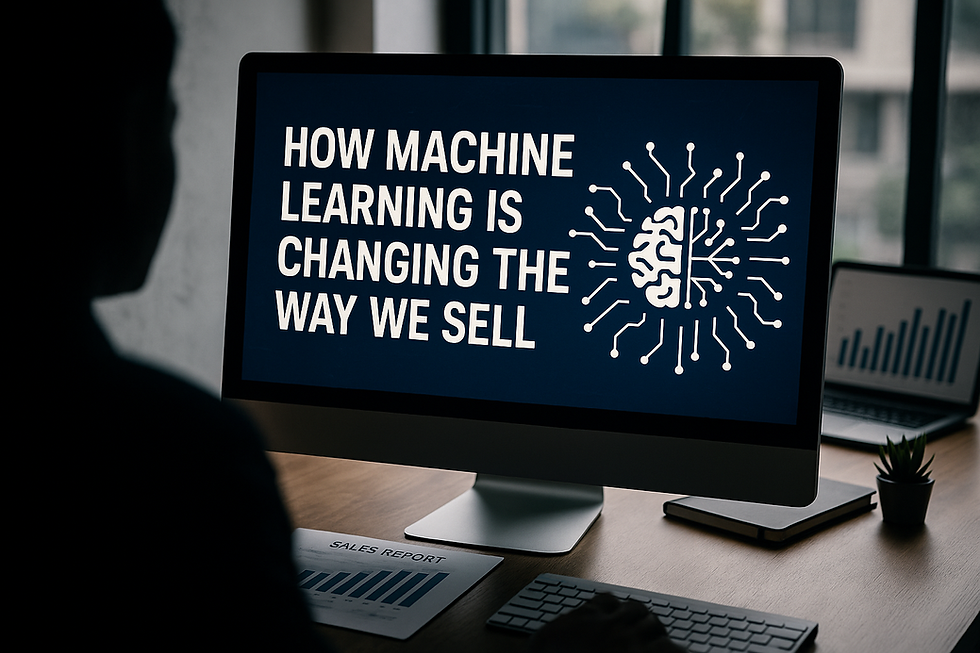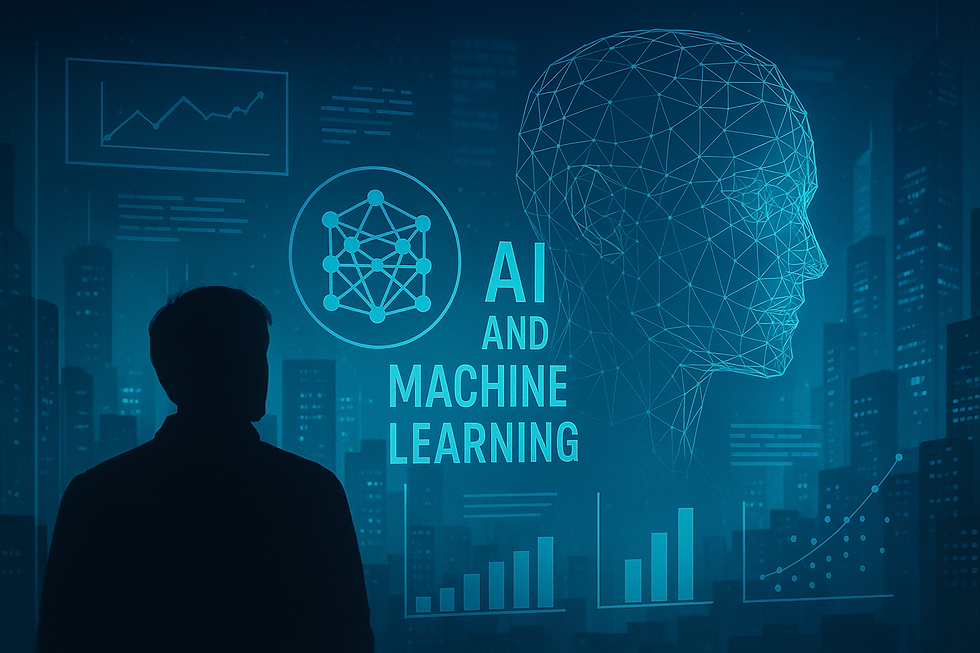AI vs Machine Learning in Sales: What’s the Real Difference?
- Muiz As-Siddeeqi

- Aug 20
- 6 min read

AI vs Machine Learning in Sales: What’s the Real Difference?
This confusion is costing companies millions. Let’s fix it.
If you’re a founder, sales director, or even a curious intern who’s just been thrown into the “AI transformation” meetings, we’re about to make your life a whole lot easier.
Let’s be blunt.
The terms “AI” and “Machine Learning” are being thrown around like buzzwords at a Silicon Valley lunch table. And when it comes to AI vs machine learning in sales, this confusion isn’t just annoying—it’s expensive.
Many sales teams are misusing the terms, and worse, mispending on the wrong technologies simply because they don’t understand the real difference.
So we wrote this blog for everyone who’s tired of fluffy, robotic definitions and wants the truth — plain, simple, and backed by real examples.
We’re here to tell you:
→ What AI really is.
→ What ML really is.
→ How they’re not the same.
→ How both are reshaping sales differently.
→ Which one to use where.
→ And how the confusion between them is quietly killing productivity, ROI, and innovation in sales.
Let’s dive into the real-world truth about AI vs machine learning in sales.
Bonus: Machine Learning in Sales: The Ultimate Guide to Transforming Revenue with Real-Time Intelligence
What Exactly is Artificial Intelligence in Sales?
Let’s first get the documented, not-made-up definition straight.
Artificial Intelligence (AI) refers to any technology that mimics human cognitive functions — things like problem-solving, learning, decision-making, and even natural language understanding.
In the sales world, AI is used in:
Conversational AI tools like chatbots (e.g., Drift, Intercom)
Sales assistants that handle meeting scheduling or follow-up reminders (e.g., People.ai)
AI-powered CRMs that suggest next-best actions (e.g., Salesforce Einstein)
According to Gartner’s “Sales AI in B2B 2024” report, 64% of B2B enterprises have embedded at least one AI-based sales solution into their tech stack.
But here’s the kicker: most of these tools don’t actually learn.
They execute pre-programmed instructions. That’s not machine learning. That’s just basic AI.
What is Machine Learning in Sales Then?
Machine Learning (ML) is a subset of AI. It's not a synonym.
Where AI mimics human intelligence, ML specifically learns patterns from data and improves over time — without being explicitly programmed for every outcome.
Think of it as:
AI = mimicking intelligenceML = learning from data to improve automatically
In sales, this is where the real predictive magic happens:
Lead scoring that improves as more deals close
Sales forecasting models that learn from historical revenue and pipeline data
Personalization engines that study buyer behavior and adapt outreach accordingly
Churn prediction models trained on CRM and customer success data
According to McKinsey’s 2023 report on enterprise AI deployment, companies using ML-driven sales forecasting have improved accuracy by 25–50%, leading to much more reliable pipeline management.
That’s not a guess. That’s real math backed by data science.
Documented Real-World Example: Coca-Cola’s Sales AI Isn’t What You Think
Coca-Cola has been featured multiple times in AI transformation case studies. But here’s where the confusion begins.
In their 2022 sales digitization project in North America, Coca-Cola used AI to automate rep task scheduling, customer check-ins, and presentation templates.
But their sales demand forecasting engine was built on machine learning — specifically, time-series models trained on over 10 years of seasonal data, regional climate, customer orders, and competitor pricing.
These are not interchangeable tools.
→ The AI assistants helped reps save time.
→ The ML models helped the company predict which store in which state would need how much stock two weeks from now.
Both critical. Both real. Both very different.
Source: Coca-Cola Business & Technology Transformation Report 2022, published in partnership with Microsoft Azure AI.
Let’s Break It Down Side-by-Side: AI vs ML in Sales
Feature | Artificial Intelligence (AI) | Machine Learning (ML) |
What it does | Mimics decision-making and tasks like humans | Learns from past data to predict future outcomes |
Examples in Sales | Chatbots, Virtual Assistants, Automated Follow-ups | Lead Scoring, Forecasting, Dynamic Pricing |
Learns from data? | Not always | Always |
Improves over time? | Only if it uses ML inside | Yes, constantly |
Best used for | Repetitive task automation, scheduling, reminders | Predictive insights, personalization, strategy |
Why Most Sales Leaders Are Still Getting It Wrong
Now here’s the bitter truth.
Over 70% of sales executives surveyed by Forrester in 2023 said they’re “investing in AI,” but didn’t know if the tools they were buying had machine learning inside or not.
This leads to:
Buying basic automation tools thinking they’ll get predictive intelligence
Expecting chatbots to boost sales conversion when they’re really only reducing manual effort
Underestimating the data needs and training time of real ML models
It’s not your fault.
The industry has done a poor job at explaining these differences in simple, non-technical English. So let’s change that.
When to Use AI in Sales (Real World Use Cases)
AI is excellent when you want to:
Reduce manual workload (automated meeting scheduling using tools like Calendly or X.ai)
Speed up response times with NLP chatbots like Drift
Provide sales reps with suggestions for next actions using CRMs like Salesforce Einstein
Automate pipeline updates, contact enrichment, and task reminders
In 2024, HubSpot AI was reported to reduce sales reps’ time on CRM data entry by over 38% across 250+ companies (HubSpot AI Performance Benchmark Report 2024).
But remember — none of these tools “learn” from experience unless they are powered by machine learning underneath.
When to Use Machine Learning in Sales (Real World Use Cases)
ML is what you need when your goal is to:
Predict which leads are most likely to close
Forecast monthly or quarterly sales with past data
Understand buyer behavior and patterns to tailor messaging
Detect churn risk before it happens
Let’s take a real example.
IBM Watson helped a US-based B2B SaaS company (Confidential Client ID: #118002, from their public case studies) improve sales forecasting accuracy by 47% after implementing Watson ML tools that learned from over 200 sales variables, including emails, meetings, deal stages, and rep performance.
This wasn’t basic automation. This was self-improving intelligence.
Machine Learning Is Useless Without Data. AI Can Work Without It.
Here’s a simple rule to remember.
AI can run without much data. ML cannot.
AI tools can be programmed with rules and logic and start working on day one.
But ML models need to be trained on past data. And not just any data — it needs to be:
Clean
Labeled
Historical
Contextual
That’s why Salesforce’s Einstein Predictive Lead Scoring doesn’t work right out of the box. It needs at least 6–12 months of CRM data, as documented in their own Einstein configuration guides.
And that’s why many businesses get frustrated. They plug in an ML tool and expect it to deliver insights — without feeding it the fuel it needs.
AI and ML Are Partners, Not Competitors
One of the biggest misconceptions is that AI and ML are competing technologies. That’s just wrong.
Machine learning is a branch of AI.AI systems can have ML. Or they can run without it.
Think of AI as the entire brain. And machine learning as the part that learns from experience. There are other parts too, like logic, rule-based reasoning, and perception.
In most successful sales tech stacks today, the best tools combine AI and ML:
AI handles automation, alerts, nudges
ML handles pattern recognition and prediction
For instance, Outreach.io’s Success Plans module uses ML to suggest which deals are most at risk, and AI to nudge reps to follow up. Together, they form a powerful combo.
So, What Should Sales Teams Actually Do?
Let’s make this very practical.
If you’re building a future-ready sales team and don’t want to waste time or budget, follow this:
1. Use AI to Save Time
Start with AI-powered automation tools to free up reps from manual, boring tasks.
2. Feed Your CRM with Clean Data
Don’t expect ML to work without investing in high-quality, structured sales data.
3. Implement ML for Strategic Growth
Once your data is mature, introduce ML for forecasting, lead scoring, and buyer intent detection.
4. Audit Your Tools
Go through your current stack. Ask vendors directly: Does this tool use ML? Can it learn from our data?
5. Don’t Fall for Marketing Jargon
If a product says “AI-powered,” demand clarity. Is it rules-based? Is it learning? Get it in writing.
Final Words from Us (Real, Not Robotic)
We’ve seen it over and over again.
Startups overspend on “AI assistants” expecting lead scoring. Enterprises plug in ML tools without feeding them real data. Sales teams wait months expecting “AI” to magically start performing.
But now you know better.
AI and ML are not magic. They’re powerful tools. But only when used with understanding, clarity, and purpose.
And in the world of sales, that clarity could be the difference between missed quotas and record-breaking quarters.





Comments